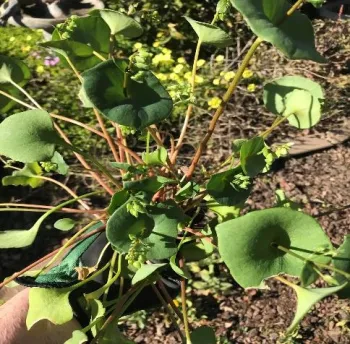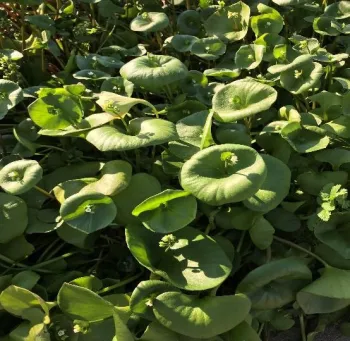Herb Study: Miner’s Lettuce (Winter Purslane)
Herb Study: Miner's Lettuce (Winter Purslane)
Regina Brennan, Master Gardener
Miner's lettuce gets its name from the workers who traveled to California during the Gold Rush. Needing a source of vitamin C, gold miners learned from the Native Americans that this wild growing green would prevent scurvy and other vitamin C-related issues. Miner's lettuce is native to the western coastal and mountain regions of North America and was spread to Europe in the late 1700s when it was brought back from an expedition to the new world. It grows wild in California from Sacramento to the San Joaquin Valley. It appears most often in the spring. Today, because of the availability of fruits and vegetables, scurvy is not as problematic as it was in the Gold Rush days. And, alas, this once valued wild green has been relegated to the status of yet another spring weed. It is, however, a good source of food for animals, providing a grazing source for cattle and flocking birds.

With no knowledge of the hidden health treasure of this wild green, I have been pulling it from my garden every year, along with the other abundant spring weeds, relegating it to the status of organic trash, and sending it off in the green cart picked up weekly. Yes, I compost, no I do not compost weeds.
Just as the gold miners were shown the health benefits of this abundant wild green, I learned of it when a neighbor brought me a bowl of soup she had made. The soup was tasty, but it had a very large glob of greens that had to be eaten with a fork. I asked her what the greens were, and if she had grown them. She proceeded to tell me that another neighbor had given them to her and that he called it miner's lettuce. My gardener's curiosity was peaked, and I discovered that his cover crop of delicious greens was identical to the annoying weed I had been treating with less than respect.
According to several online sources, Miner's lettuce is a native winter annual broadleaf plant in the Montiaceae family. The flowers, leaves, stems, and roots are edible. Young leaves can be consumed raw or cooked. The plant can grow up to 12 inches, but is generally smaller. It is similar to spinach and is best suited for both raw and cooked applications, such as steaming, boiling, stir-frying, or sautéing. To avoid the glob effect, I would suggest cutting the leaves and stems into smaller pieces before cooking. The leaves will keep three to four days when stored in a sealed container with a damp paper towel in the crisper drawer of the refrigerator.

What does Miner's lettuce look like? It is a small, herbaceous, slightly succulent plant. It is light green in color, and has round, disk-like leaves, which surround its smooth, tender stem. The stem passes directly through the round leaf, and this makes identification easy. After the plant has bloomed, there is a small white or pinkish color flower growing on top of its rounded leaves. Young leaves are tastiest, as older leaves can turn bitter in the summer in a hot dry location. According to a study in the journal of the American Dietetic Association, 100 grams of miner's lettuce contains a third of your daily requirement of vitamin C, 22 percent of vitamin A, and 10 percent of iron.
Who would have guessed that such a wild plant, aka weed, has such an interesting history? I hope that shedding some light on this humble plant will encourage you to look in your garden to see if you are lucky enough to find a nutritious green that is worthy of serving your family for dinner. Bon appétit!
